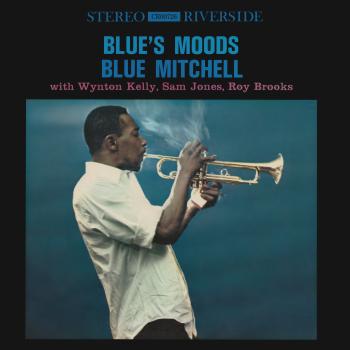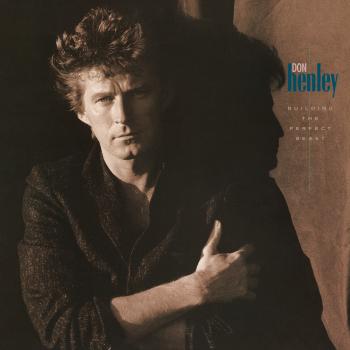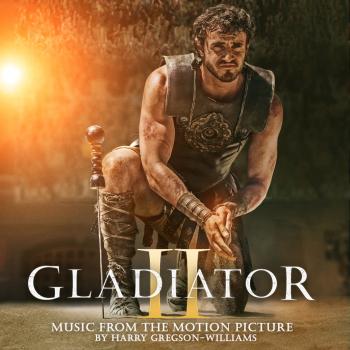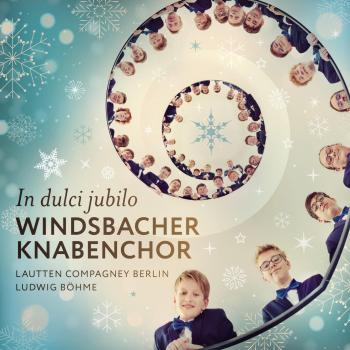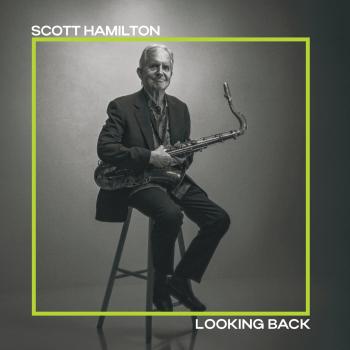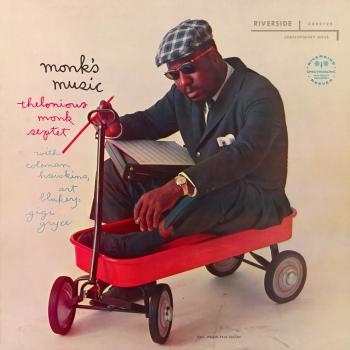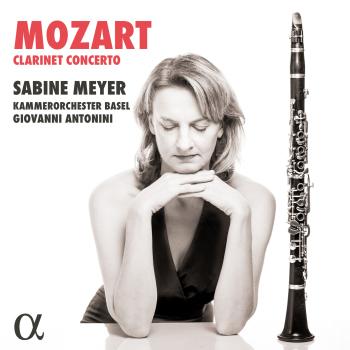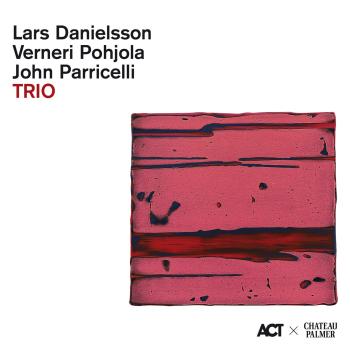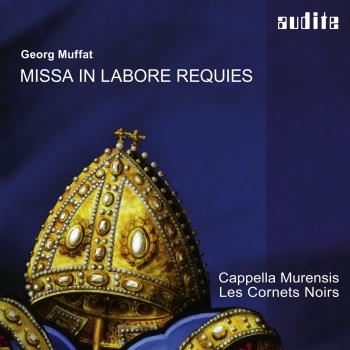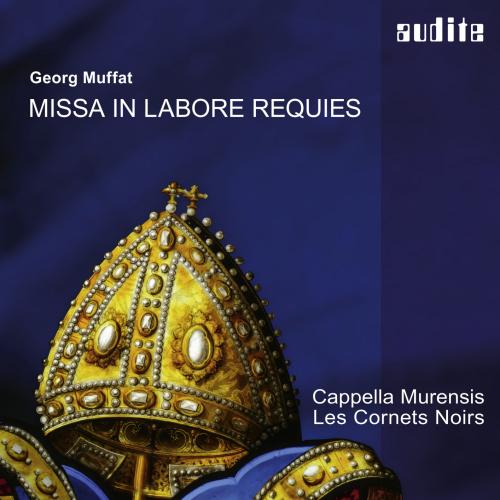
Muffat: Missa in labore requies Cappella Murensis & Les Cornets Noirs
Album info
Album-Release:
2016
HRA-Release:
09.06.2017
Label: audite Musikproduktion
Genre: Classical
Subgenre: Vocal
Artist: Cappella Murensis & Les Cornets Noirs
Composer: George Muffat
Album including Album cover Booklet (PDF)
- Georg Muffat (1653-1704): Missa in labore requies à 24:
- 1 Kyrie: Sonata 00:59
- 2 Kyrie: Kyrie I 01:53
- 3 Kyrie: Christe 01:05
- 4 Kyrie: Kyrie II 01:58
- 5 Gloria: Et in terra pax 01:36
- 6 Gloria: Laudamus te 01:48
- 7 Gloria: Gratias agimus tibi 01:03
- 8 Gloria: Domine Deus 01:01
- 9 Gloria: Qui tollis peccata mundi 03:53
- 10 Gloria: Quoniam tu solus sanctus 02:12
- 11 Gloria: Cum Sancto Spiritu 02:35
- 12 Credo: Patrem omnipotentem 01:18
- 13 Credo: Et in unum Dominum 02:52
- 14 Credo: Qui propter nos homines 02:16
- 15 Credo: Et incarnatus est 01:11
- 16 Credo: Crucifixus 02:27
- 17 Credo: Et resurrexit 01:50
- 18 Credo: Et in Spiritum Sanctum 04:32
- 19 Sanctus: Sanctus 01:46
- 20 Sanctus: Hosanna 01:31
- 21 Benedictus: Benedictus 00:49
- 22 Benedictus: Hosanna 01:35
- 23 Agnus Dei: Agnus Dei 01:48
- 24 Agnus Dei: Dona nobis pacem 02:02
- Antonio Bertali (1605-1669):
- 25 Sonata a 13, A 540/IV:94 04:10
- Heinrich Ignaz Franz Biber (1644-1704):
- 26 Sonata VI a 5 05:13
- Johann Heinrich Schmelzer (1623-1680):
- 27 Sonata XII a 7 04:23
- Heinrich Ignaz Franz Biber:
- 28 Sonata VIII a 5 05:23
- Antonio Bertali:
- 29 Sonata Sancti Placidi a 14, A 548/IV:102 06:10
Info for Muffat: Missa in labore requies
Georg Muffats monumentale Messe und Kirchensonaten seiner Zeitgenossen lassen in dieser Aufnahme einen lebendigen Eindruck von der repräsentativen Kirchenmusik führender katholischer Höfe im Hochbarock entstehen. In der Klosterkirche Muri mit ihren vier Emporen finden die mehrchörigen Werke unter Einbeziehung der historischen Bossart-Orgeln einen Aufführungsort von seltener klanglicher Authentizität.
Mit Georg Muffats "Missa in labore requies" und Kirchensonaten seiner Zeitgenossen setzt audite die Reihe mehrchöriger Barockmusik mit namhaften Künstlern der Alten Musik-Szene fort.
Die Klosterkirche in Muri bietet mit ihrem oktogonalen Grundriss und den vier Musizieremporen die perfekten räumlich-akustischen Voraussetzungen für die Aufführung mehrchöriger Musik. Die Emporen umrahmen den Hauptraum der Kirche, so dass sich der Zuhörer inmitten des musikalischen Geschehens wiederfindet. Dieses Klangerlebnis ist einzigartig, sowohl im Konzert als auch in den Aufnahmen. Die nicht unerhebliche Distanz zwischen den Emporen stellt dabei durchaus eine Herausforderung für das Zusammenspiel der einzelnen Klanggruppen dar. Sie ist aber ein wesentlicher Teil der Komposition selbst, denn erst die räumliche Trennung der Chöre verleiht der Musik die beabsichtigte Weite und Größe. Adäquate Raumbedingungen sind darum ein entscheidender Faktor für eine authentische Umsetzung solcher Werke. Die vorliegende Aufnahme gibt die erzielbaren Klangwirkungen der eingespielten Werke hervorragend wieder. Die zwei historischen Bossart-Orgeln von 1743 verleihen der Musik zudem ein echtes Continuo-Fundament und prägen ebenfalls wesentlich den beeindruckenden Gesamtklang der Aufnahme.
Von Georg Muffat ist mit der "Missa in laborerequies" nur ein einziges, dafür aber monumentales Werk der Kirchenmusik erhalten. 24 Stimmen werden auf fünf getrennt von einander positionierte Chöre verteilt. Dabei nutzt Georg Muffat die Möglichkeiten der üppigen Besetzung. So wird die zentrale Klangpracht des zweifellos für einen höchst repräsentativen Anlass komponierten Werks immer wieder von Sätzen abgelöst, die den Vokalsolisten Gelegenheit geben, in virtuosen wie expressiven Passagen hervorzutreten. Bester Kontrapunkt im alten Stil steht neben modernem Konzertieren der einzelnen Chöre, wobei die piano-Stellen der großen Tutti-Echos eindrucksvolle Wirkung erzeugen - nur noch übertroffen von den gestopften Trompeten und gedeckten Pauken, die das "passus et sepultus est" mit einem düsterenTrauermarsch begleiten.
Kirchensonaten von Zeitgenossen Muffats in unterschiedlicher Besetzung runden die Aufnahme ab.
Miriam Feuersinger, Sopran
Stephanie Petitlaurent, Sopran
Alex Potter, Alt
William Purefoy, Alt
Hans Jörg Mammel, Tenor
Manuel Warwitz, Tenor
Markus Flaig, Bass
Lisandro Abadie, Bass
Cappella Murensis
Trompetenconsort Innsbruck
Les Cornets Noirs
Johannes Strobl, Leitung
Cappella Murensis
The Cappella Murensis was founded by Johannes Strobl in 2002 as the professional vocal ensemble of the Abbey Church of Muri. According to the musical task in hand, the Cappella Murensis performs as an ensemble of vocal soloists, a chamber choir, or a Gregorian choir. One of the main focuses of Johannes Strobl and the Cappella Murensis is church music of the 16th to the 18th centuries, which is particularly suited to performance in the Abbey Church of Muri. In this period, the contribution of his- torical organs belongs of course de facto to the musical practice: alongside all forms of polychorality, particular attention is devoted to the connection between organ music and Gregorian chant that forms part of the Benedictine heritage of the Abbey Church of Muri.
With the Cappella Murensis, Johannes Strobl regularly organises performances of liturgical compositions that have been re-discovered in Swiss monasteries, which are also documented in radio recordings. Thus the ensemble has performed at the Festi- val international des musiques sacreés in Fribourg, at the International Bach Festival in Schaffhausen, in the banqueting hall of the monastery at Einsiedeln, in St. Gallen Cathedral, and at the Early Music Festival in Utrecht.
In collaboration with Thilo Hirsch and the ensemble arcimboldo, the Cappella Murensis has previously issued a recording of Johann Valentin Rathgeber’s “Missa solennis in D” op. 12/12 with audite. A second SACD, “Polychoral Splendour”, with polychoral works by Heinrich Schütz and Giovanni Gabrieli, was awarded the distinc- tion of the International Classical Music Award 2013.
Les Cornets Noirs
In recent years the instrumental ensemble Les Cornets Noirs, which specialises in Italian and German Early Baroque music, has made a name for itself internationally. Founded in 1997 by Gebhard David and Bork-Frithjof Smith, the main interest of the group lies in solo and ensemble literature for the cornett (It. cornetto, Fr. cornet – also called “black cornett” because of its leather covering), which experienced its hey-day from the middle of the 16th to the late 17th century north and south of the Alps.
Les Cornets Noirs were prize winners in the concours musica antiqua at the Festival van Vlaanderen Brugge 2000. Since then, the ensemble has performed at festivals in Switzerland, Austria, Germany, the Czech Republic, Poland, France, Luxemburg, Italy, and Portugal, both with their own programmes and in collaboration with vocal groups for the performance of large-scale Early Baroque works by Giovanni Gabrieli, Heinrich Schütz, Claudio Monteverdi, Georg Muffat, Heinrich Ignaz Franz Biber, and their contemporaries.
Les Cornets Noirs have also already issued two successful recordings with audite („Echo & Risposta“ and „Polychoral Splendour“).
Johannes Strobl
The Austrian-born musician Johannes Strobl received his rst piano and organ lessons at the music school of Spittal an der Drau with Hermann Zeyß. He graduated from the Hochschule für Musik und Darstellende Kunst “Mozarteum” in Salzburg with Heribert Metzger and was awarded distinctions in both his teaching and soloist di- ploma in organ and his advanced degree in Catholic Church Music. This was followed by comprehensive studies in Early Music at the Schola Cantorum Basiliensis with Jean-Claude Zehnder (organ), Jörg-Andreas Bötticher (harpsichord), Jesper Chris- tensen ( gured bass) and Rudolf Lutz (improvisation), and additional masterclasses with Michael Radulescu, Luigi Ferdinando Tagliavini, Harald Vogel, Almut Rössler and James David Christie.
Johannes Strobl was a prize winner at the Paul Hofhaimer competition in Innsbruck in 1998. His musical activities as a soloist and ensemble player have taken him to many European countries and further a eld to Israel, Japan, the US, Brasil, and Argentina.
Since 2001, Johannes Strobl has been employed as Director of Music of the Catholic parish of Muri in the Swiss canton of Aargau. In this role, he oversees the important historical organs of the church of the former Benedictine monastery and is artistic director of a distinguished concert series. He also teaches Improvisation and Liturgical Organ Playing at the Hochschule Luzern in the music faculty’s department of church music.
Booklet for Muffat: Missa in labore requies


